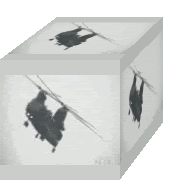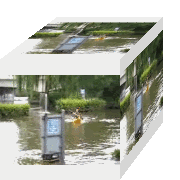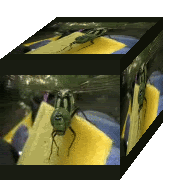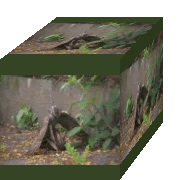 In the corner of this field lies a secret...
In the corner of this field lies a secret... You could walk past it without noticing, and that's the idea.
You could walk past it without noticing, and that's the idea. Look on the other side of this grassy knoll and all is revealed. A 'blast wall' only recently toppled, partly obscures the entrance.
Look on the other side of this grassy knoll and all is revealed. A 'blast wall' only recently toppled, partly obscures the entrance. Clamber through the brambles, under the leaning edge of the wall and a dark corridor awaits you.
Clamber through the brambles, under the leaning edge of the wall and a dark corridor awaits you. At the end of the passage, turn right, into a small windowless room. The only light pours through the escape hatch above.
At the end of the passage, turn right, into a small windowless room. The only light pours through the escape hatch above. The metal rungs of the ladder have long since gone.
The metal rungs of the ladder have long since gone. In the corner is a plinth where once a stove sat.
In the corner is a plinth where once a stove sat. 
This was the hide of the Elite Auxiliary Unit in world war two. These units were a subversive underground force formed to operate behind enemy lines if we were invaded. Trained in guerrilla tactics and armed with rifles, grenades, incendiary bombs, plastic high explosives, time delay fuses and other devices, these men were expected to target tanks, convoys, enemy camps, and ammunition dumps. Sworn to secrecy and forced to sign the Official Secrets Act, they operated outside of the Geneva Convention and if caught could be shot as spies.
 The adjoining room was pitch black. Torchlight revealed a ceiling inhabited by hibernating butterflies and moths exercising an uneasy truce with the large spiders.
The adjoining room was pitch black. Torchlight revealed a ceiling inhabited by hibernating butterflies and moths exercising an uneasy truce with the large spiders. This room was slightly smaller, the floor dominated by two large concrete slabs. Inset to these were the remnants of metal mounting points. This was probably the location of the battery generators which would have been used to power a radio transceiver.
This room was slightly smaller, the floor dominated by two large concrete slabs. Inset to these were the remnants of metal mounting points. This was probably the location of the battery generators which would have been used to power a radio transceiver. Three wide ventilation pipes bridged the walls. Two at floor level and one 5ft up the wall so ensuring a natural flow of air through convection. Two smaller metal pipes were probably exhaust outlets for the engines of the generators.
Three wide ventilation pipes bridged the walls. Two at floor level and one 5ft up the wall so ensuring a natural flow of air through convection. Two smaller metal pipes were probably exhaust outlets for the engines of the generators. The hatch from the escape route was missing. This bunker doesn't appear on any civilian maps, and this is the only feature to be seen on any ariel photographs.
The hatch from the escape route was missing. This bunker doesn't appear on any civilian maps, and this is the only feature to be seen on any ariel photographs.






.jpg)




